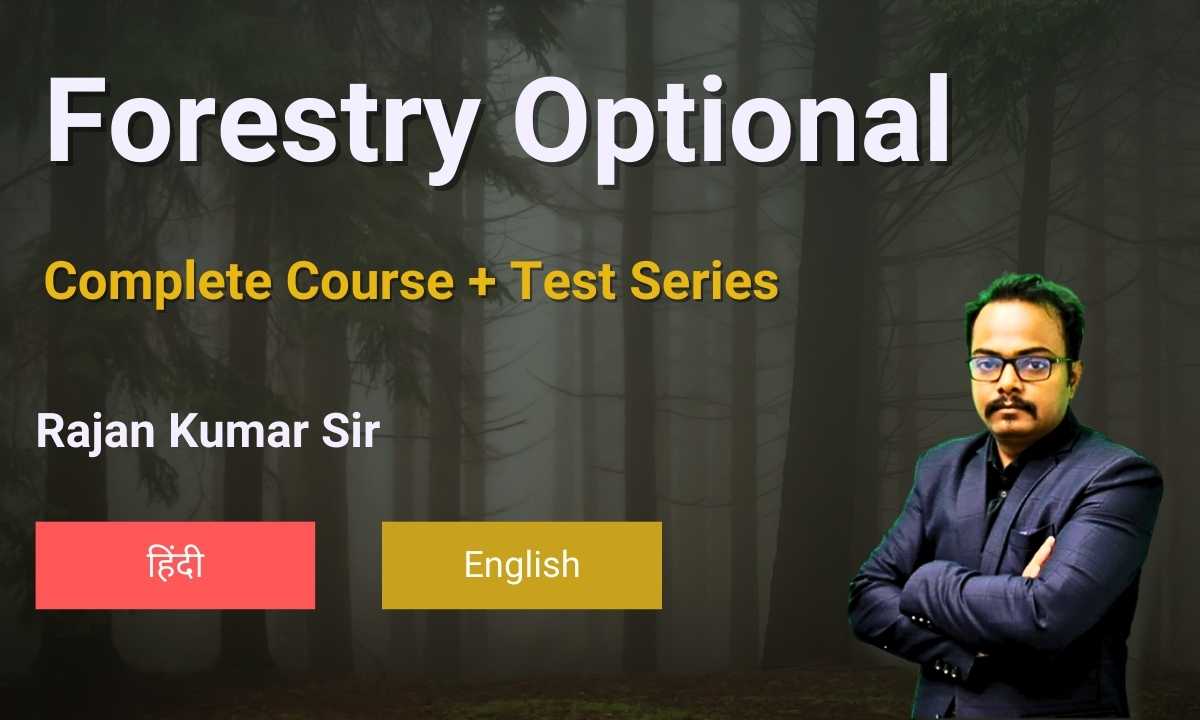Forestry Optional Course
Description
Forestry Optional Course – Complete Details
Course Completion : 31st October 2025
Test Series : Included
Answer Writing : Included
📘 Paper I – Forestry (Fundamentals, Silviculture, Environment, Economics)
Unit 1: Silviculture
-
General Principles: ecological & physiological factors, natural/artificial regeneration, nursery techniques, propagation, seed technology.
-
Silvicultural Systems: Clear felling, uniform shelterwood, coppice, conversion systems.
-
Plantation Silviculture: Methods of establishment, enrichment planting, mechanized methods.
-
Silviculture of Trees: Acacia catechu, Acacia nilotica, Bamboo spp., Casuarina equisetifolia, Eucalyptus spp., Tectona grandis, etc.
-
Silviculture in Special Zones: Mangroves, cold deserts, degraded habitats.
Unit 2: Agroforestry, Social & Urban Forestry
-
Agroforestry scope, necessity, ecological and socio-economic benefits.
-
Systems across agro-ecological zones; role in soil/water conservation, biodiversity, fuel, fodder, NTFPs.
-
Social Forestry: Objectives, scope, benefits, role of NGOs.
-
JFM – principles, methodology, people’s participation.
-
Tribal forestry: livelihood, traditions, customs, cultural practices.
Unit 3: Forest Soils, Soil Conservation & Watershed Management
-
Forest soils: formation, classification, properties.
-
Soil Conservation: causes of erosion, types, techniques (wind/water erosion control, dunes stabilization, shelterbelts).
-
Watershed Management: torrent control, avalanche/landslide management, river channel stabilization.
-
Soil microorganisms, composting, nutrient cycling (N, C cycles).
Unit 4: Environment, Conservation & Biodiversity
-
Afforestation, deforestation, ecosystem balance, population growth impacts.
-
Pollution: air, water, noise – causes, control, monitoring.
-
Ozone depletion, greenhouse effect, global warming.
-
Environmental policy, law, economics of watershed management.
-
Sustainable development in forestry.
Unit 5: Tree Improvement & Seed Technology
-
Tree improvement methods – provenance trials, seed orchards, clonal forestry.
-
Seed technology – seed production, storage, viability.
-
Quantitative genetics, disease resistance, pest resistance.
-
Genetic resources – in situ & ex situ conservation.
Unit 6: Wildlife Biology
-
Forest injuries: pests, diseases, fire, abiotic/biotic stresses.
-
Wildlife conservation: grazing management, poaching control, CO₂ absorption role.
-
Control methods: rotational grazing, encroachment regulation.
Unit 7: Forest Economics & Legislation
-
Forest economics – demand-supply, valuation, cost-benefit analysis.
-
Market structures, co-operatives, corporate financing.
-
Legislation: Indian Forest Acts (1894, 1927, 1980), Wildlife Protection Act 1972, Forest Conservation Act, National Forest Policy (1988, 1990).
-
Public administration in forestry, women’s involvement, decentralization.
📗 Paper II – Forestry (Management, Utilization, Applied)
Unit 1: Forest Management & Working Plans
-
Principles of forest management – sustained yield, multiple use, forest planning.
-
Working plans – preparation, inventory, growth studies.
-
Management of natural and plantation forests.
Unit 2: Forest Mensuration & Surveying
-
Measurement of diameter, height, volume, form factor.
-
Growth and yield estimation, increment studies, sampling techniques.
-
Yield tables, forest inventory methods.
-
Surveying and mapping – basic methods.
Unit 3: Forest Engineering & Utilization
-
Engineering structures in forestry – roads, bridges, buildings.
-
Logging methods, extraction, transport.
-
Timber mechanics – wood properties, seasoning, preservation.
-
Pulp & paper, plywood, composites.
-
Minor forest products – lac, resins, gums, medicinal plants.
Unit 4: Forest Protection
-
Causes of forest damage – fire, pests, diseases, weeds.
-
Fire control – prevention, suppression techniques.
-
Biological, chemical, mechanical control of pests/diseases.
-
Climate hazards – frost, drought, windthrow.
Unit 5: Forest Policy & Administration
-
History of Indian Forest Policy, National Forest Policy.
-
Forest legislation and administration structure.
-
Institutional setup – ICFRE, FSI, State Forest Departments.
-
Role of Panchayats and communities.
Unit 6: Forest Products & Industries
-
Wood utilization – mechanical, chemical, bio-products.
-
Non-wood products – bamboo, cane, medicinal plants, fodder.
-
Economics of forest industries, sustainable harvesting.
Unit 7: Modern Forestry Applications
-
Remote sensing, GIS, forest mapping.
-
Climate change and forestry.
-
Eco-restoration of degraded lands.
-
Carbon sequestration and REDD+.
🗓️ 2-Month Weekly Plan (8 Weeks)
-
Week 1: Silviculture (Principles, Systems, Species)
-
Week 2: Plantation Forestry + Agroforestry + Social Forestry
-
Week 3: Forest Soils + Soil Conservation + Watershed Management
-
Week 4: Environment, Biodiversity, Tree Improvement, Seed Technology
-
Week 5: Wildlife Biology + Forest Economics + Legislations
-
Week 6: Forest Management + Working Plans + Forest Mensuration
-
Week 7: Forest Engineering + Utilization + Forest Protection
-
Week 8: Forest Policy + Forest Industries + Modern Forestry (Remote Sensing, Climate Change) + Full Revision & PYQs
📌 Course Deliverables
-
Complete Coverage of Paper 1 & 2
-
Answer Writing Practice with diagrams, flowcharts, case studies
-
Weekly Assignments & MCQs
-
Previous Year Question Analysis (trend + model answers)
-
Doubt Clearance Sessions
-
Final Full-Length Mock Test (Paper I + Paper II)
Loading...

